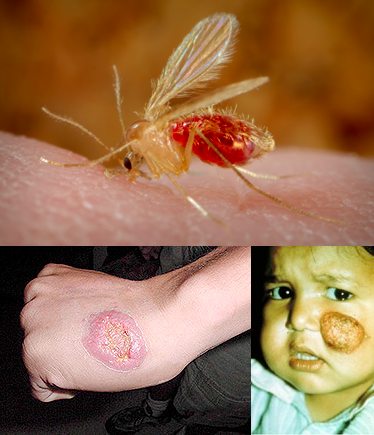Travel to distant lands leads to great opportunities to explore biodiversity up close. However, it is important to keep some of the biodiversity, especially topical diseases and their vectors, at arms length. Institutions maintain control efforts for some of the worst diseases and their vectors. However, institutions are often disrupted by the “dogs of war” (as Shakespeare phrased it).
Currently, Southern Sudan is reporting the worst outbreak of “Black Fever” in a decade. Black fever is synonymous with Leishmaniasis, a protozoan parasite that is transmitted by bites of the sand fly of the Genus, Phlebotomus. In war zones like Sudan, access to medical treatment and insect control measures can be disrupted and diseases spread because the reservoir for the disease increases. People who are displaced or homeless by war or other disasters may have increased exposure to disease vectors.
Leishmaniasis is found in many of the desert areas of Asia, Africa and the Middle East. About a two million people are infected with Leishmaniasis every year. The most common forms of Leishmaniasis, are cutaneous (1.5 million infections per year) and visceral (one half million infections per year). Black Fever is the visceral form that infects internal organs including the spleen where the protozoan multiplies. Antimonials or other anti-parasitic agents can be used to treat Leishmaniasis. Black Fever is often lethal if not treated.
Cutaneaous Leishmaniasis causes visible sores on the skin. Between 2002 and 2004, the US military confirmed over 500 cases of cutaneous Leishmaniasis among soldiers deployed in the deserts of Asia. In Iraq, it is known colloquially as the “Bagdad Boil”. Symptoms may take weeks to appear. Since Leishmaniasis is rare in the US, doctors may fail to properly diagnose the symptoms unless the travel history is considered. Leishmaniasis can be transmitted by blood transfusion, so soldiers returning from these areas are restricted from blood donation for one year.
Most armies (and the US is no exception) employ entomologists who work to reduce exposure to insects of medical importance. Appropriate use of DEET can prevent sand fly bites and protect against Leishmaniasis transmission. In some areas, insecticides may be used to reduce populations of sand flies and other biting flies. Other efforts can reduce the reservoir of Leishmaniasis in local rodent populations. Entomologists and medical researchers continue to search for better methods of preventing Leishmaniasis and other diseases.


Pingback: The Sunday Bug Bash 3 | The Bug Whisperer
I wonder how many people with mild cases of cutaneous leishmaniasis are returning to areas of North America with possible vectors (like southern Texas)? Last summer a former British soldier who had been stationed in Afghanistan came through here with a sore on his neck that certainly looked like leishmaniasis. It seemed improbable that the army doctors would miss it, but if symptoms are mild or delayed, I guess not.
There are probably few cases of unconfirmed Leishmaniasis among the military because there are so few confirmed. Sores can have numerous causes. However, any unusual sores should be checked.
Doctors typically have a check list, or at least a mental check list of diseases that can cause symptoms they observe. However, the list is often shortened to diseases that are prevalent in an area. Unless a doctor knows the travel history, diseases such as Leishmaniasis (uncommon in North America) may not be accurately diagnosed.
Some cutaneous forms of Leishmaniasis can heal on its own, but does respond to treatment. There are 20 described species of Leishmania that can cause human disease.
As well as overly localized check lists, general practitioners do not seem to get much in the way of entomological training any more. At least, that is true in Australia and in Canada. I had one student here who came back from a vacation in Brazil with Tunga penetrans in her toes and her GP was flummoxed for several weeks (but did eventually get it). In Australia, after a field trip I once developed dozens of 2-3 cm wheals with a central vesicle over my back and shoulders. My GP wouldn’t get within a metre of me, diagnosed scabies, and sent me to a dermatologist – who kept two metres away and diagnosed flea bites! I suppose they were both keeping to their likely lists, but I knew both of these diagnoses were unlikely. If I hadn’t found a Pyemotes crawling on my arm, I doubt I would have ever found out what was wrong.
Try asking your doctor where a baby flea is likely to bite you and if he/she says ‘lower leg, ankles’ you know they know something about the adults at least.
Pingback: Cutaneous Leishmaniasis | Living With Insects Blog
Pingback: Living With Cutaneous Leishmaniasis | Living With Insects Blog
We’re a group of volunteers and oppening a brand
new scheme in our community. Your web site provided us with useful information to work on.
You’ve performed an imprssive process and our entijre community will be thankful too you.
Pingback: The Sunday Bug Bash 3 | Splendour Awaits
Pingback: Living With Leishmaniasis Liability | Living With Insects Blog